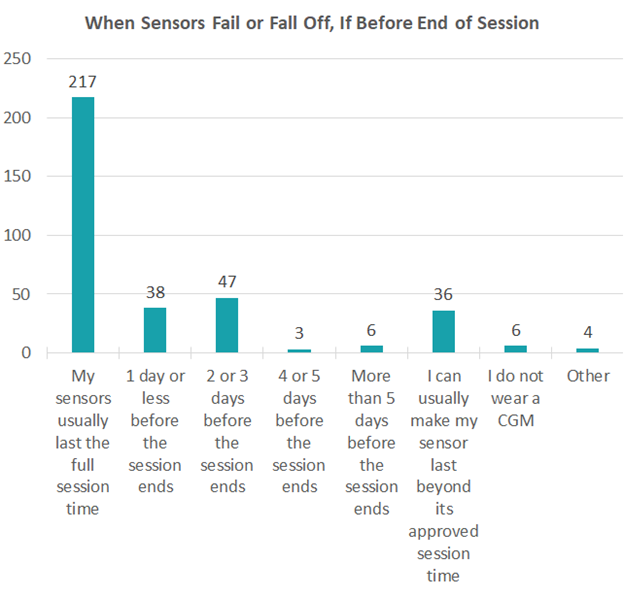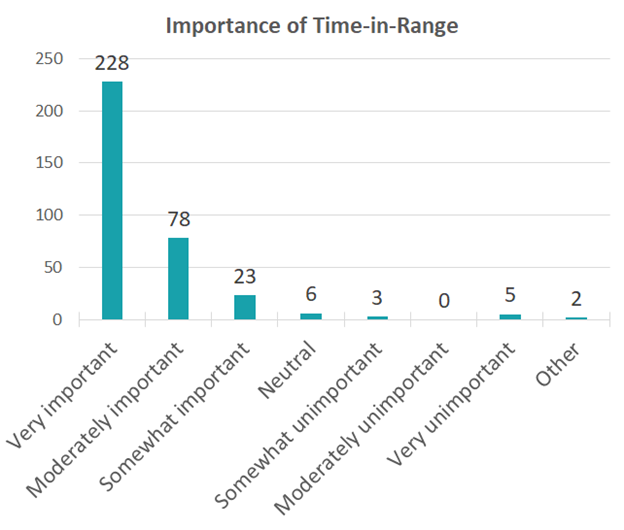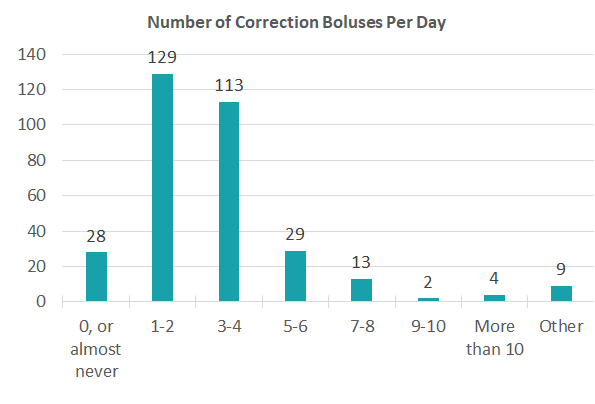
Sign up for a new account.
And get access to
The latest T1D content
Research that matters
Our daily questions
Sign up by entering your info below.
Reset Your Password
Don't worry.
We will email you instructions to reset your
password.
What We Learned from the Online Community This Month
Thank you to every member of the T1D Exchange Online Community for inspiring others who come to this community for advice and to know they’re not alone. Here is what we learned from the 3 most popular questions of March 2021!

1. CGM users: Do your sensors typically last for their full approved session duration? If not, how many days early does your sensor fail or fall off, on average?
With 365 people chiming in, this was our most popular question of March 2021! An impressive 69% of respondents reported that their sensors last the full approved session duration or even longer, with only 3% saying their sensors often end 4 or more days early.
We asked this question because when sensors fail or fall off early, there can be a lot of added stress to people with T1D. Often, insurance only covers the minimum number of sensors a person could need during a given time period.
Community members who left comments indicated that sensors failing before their session duration is supposed to be over can be frustrating, and even dangerous for some folks.
Here’s what some commenters had to say:
- “I ride a bike on hours long, fast bike rides in the heat of Summer when accurate readings are very important. I was dealing with errant readings and loosely attached sensors all Summer. I wish there was a better solution for people, like me, who exercise and sweat a lot. I’d be lucky to get 6 days out of a sensor in hot weather.”
- “My sensors last exactly the specified time, but not one minute more.”
- “Sometimes I get weird readings on the last day and bizarre readings for the first 12 hours or so of the sensor.”
- “My sensors are fine. I on the other had have had issues with my transmitter stop working.”
 2. How important is the time-in-range measurement to you?
2. How important is the time-in-range measurement to you?
The second most popular Question of the Day for March 2021 showed us that 65% of people who answered this question say the time-in-range measurement is very important to them when making T1D treatment decisions. 94% of people who answered this question indicated that time-in-range is at least somewhat important to them.
This question continues the conversation around which measurements people with T1D prefer to use when assessing if they need to make any changes to their T1D care regimen.
Here’s what the community had to say:
- “I focus on time in range and standard deviation. Those two will tell how I am doing with my treatment plan. Yes, each of us has a different range we shoot for which is why these two numbers are my numbers and can’t really compare them to others. It is my treatment plan, a plan that works for me and my life.”
- “Time in Range (TIR) is the most important measurement to use as a goal for blood glucose control. A1C is an average so if BGs are wildly ranging from 300+ to under 45 and you have more lows than highs or more time in the low range than the high range, your A1C measurement is not accurate as a measure of control.”
- “Time in range is a useful measure, but unless it includes a readout of time frames out of range, it is only part of the picture. It needs to be included with time out of range by time frame and percentage.”
- “TIR is much more helpful than A1c for me. A good A1C may have meant I was hypoglycemic a lot of the time with super high peaks, from over treating the low BG. Or what I lovingly refer to as yo-yoing.”
 3. On average, how many correction boluses would you estimate you give yourself in a day, excluding the times you’re bolusing for food?
3. On average, how many correction boluses would you estimate you give yourself in a day, excluding the times you’re bolusing for food?
This Question of the Day had a bit more of an even distribution than the other popular questions, with 38% reporting that they give 1 or 2 correction doses on a typical day. 15% of people answered that they on average give at least 5 correction doses in a day, with 8% responding that they don’t often need to give any correction boluses outside of meals at all.
Many community members indicated in the comments that recent technology has made it so that they rarely have to give correction boluses, but that every day with T1D is different.
Here is what some folks shared:
- “Depends on how focused my personal physical, emotional, and mental energy is for the day and if I am being fully mindful of each diabetes self-care step. Usually, the Control IQ corrects whatever needs to be tweaked.”
- “I’m not looping or using Control-IQ. I usually don’t have any correction boluses other than as part of a meal bolus, but there are some days where my blood sugar spikes for no apparent reason and requires several correction boluses before I get back into my normal range.”
- “I don’t correct at all but Loop with auto bolus does an average of 57 micro boluses a day to keep me in range 92% of the time.”
- “Gastroparesis wreaks havoc with digestive speed. Even the Control IQ gets challenged and requires manual intervention.”
We learn something new every day from this community’s Question of the Day responses. Thank you for sharing your experiences and wisdom with us!
If you are not already a member of the T1D Exchange Online Community, join us by clicking the “Join” button at the top of this page.







